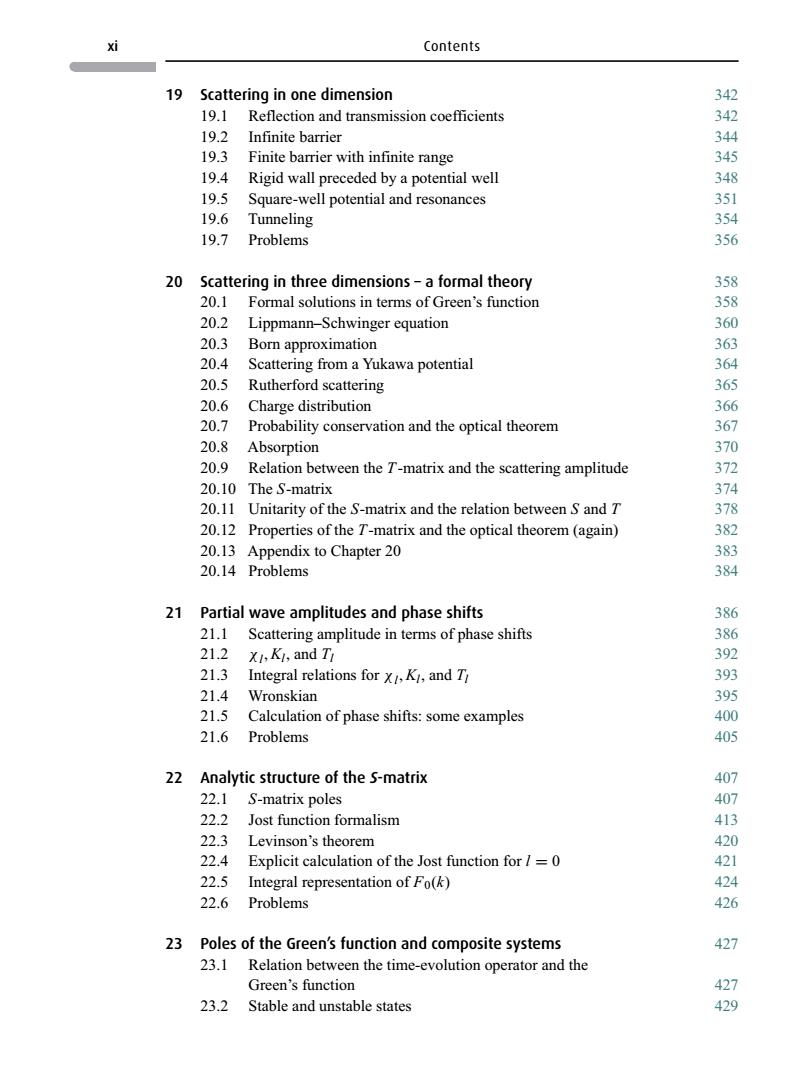正在加载图片...

Contents 19 Scattering in one dimension 342 19.1 Reflection and transmission coefficients 19.2 Infinite barrier 19.3 Finite barrier with infinite range 345 19.4 Rigid wall preceded by a potential well 348 19.5 19.6 Square-well potential and sonances Tunneling 19.7 Problems 356 20 Scattering in three dimensions-a formal theory 20. Formal solutions in terms of Green's function 20.2 Lippmann-Schwinger equation 20.3 Born approximation 204 205 g from a Yukawa potential Rutherford scattering 20.6 Charge distribution 6 207 Probability conservation and the optical theorem 36 20.8 209 Absorption 370 Relation between the T-matrix and the scattering amplitude 20.10 The S-matrix 374 20.11 Unitarity of the S-matrix and the relation between S and T 378 20.12 Properties of the T-matrix and the optical theorem(again) 380 20.13 Appendix to Chapter 20 383 20.14 Problems 384 21 Partial wave amplitudes and phase shifts 3 21. Scattering amplitude in terms of phase shifts 386 21.2 y.Ki.and T 39 213 Integral relations for x.K.and T 393 214 Wronskian 21.5 Calculation of phase shifts:some examples 21.6 Problems 405 22 Analytic structure of the S-matrix 407 S-matrix poles 22.2 Jost function formalism 413 22.3 Levinson's theorem 420 ))4 Explicit calculation of the Jost function for/=0 421 22.5 Integral representation of Fo(k 22.6 Problems 23 Poles of the Green's function and composite systems 427 23.1 Relation between the time-evolution operator and the Green's function 427 23.2 Stable and unstable states 429 xi Contents 19 Scattering in one dimension 342 19.1 Reflection and transmission coefficients 342 19.2 Infinite barrier 344 19.3 Finite barrier with infinite range 345 19.4 Rigid wall preceded by a potential well 348 19.5 Square-well potential and resonances 351 19.6 Tunneling 354 19.7 Problems 356 20 Scattering in three dimensions–aformal theory 358 20.1 Formal solutions in terms of Green’s function 358 20.2 Lippmann–Schwinger equation 360 20.3 Born approximation 363 20.4 Scattering from a Yukawa potential 364 20.5 Rutherford scattering 365 20.6 Charge distribution 366 20.7 Probability conservation and the optical theorem 367 20.8 Absorption 370 20.9 Relation between the T-matrix and the scattering amplitude 372 20.10 The S-matrix 374 20.11 Unitarity of the S-matrix and the relation between S and T 378 20.12 Properties of the T-matrix and the optical theorem (again) 382 20.13 Appendix to Chapter 20 383 20.14 Problems 384 21 Partial wave amplitudes and phase shifts 386 21.1 Scattering amplitude in terms of phase shifts 386 21.2 χl, Kl, and Tl 392 21.3 Integral relations for χl, Kl, and Tl 393 21.4 Wronskian 395 21.5 Calculation of phase shifts: some examples 400 21.6 Problems 405 22 Analytic structure of the S-matrix 407 22.1 S-matrix poles 407 22.2 Jost function formalism 413 22.3 Levinson’s theorem 420 22.4 Explicit calculation of the Jost function for l = 0 421 22.5 Integral representation of F0(k) 424 22.6 Problems 426 23 Poles of the Green’s function and composite systems 427 23.1 Relation between the time-evolution operator and the Green’s function 427 23.2 Stable and unstable states 429